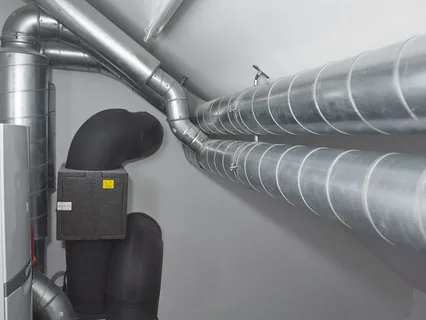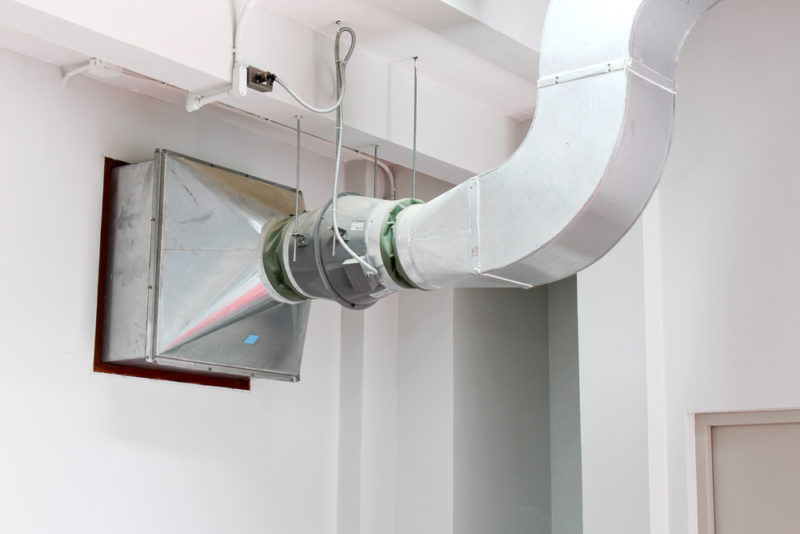Maintaining a healthy and comfortable indoor environment is paramount in today’s modern homes. With people spending significant time indoors, proper ventilation becomes essential for ensuring optimal air quality and comfort. A home ventilation system is a proactive solution, continuously circulating fresh air throughout the home while expelling stale air, excess moisture, and pollutants. This introductory guide delves into the importance of ventilation systems, shedding light on their functionality, benefits, and considerations for homeowners.
Why Ventilation Matters: Understanding the Importance of Air Quality
The air we breathe is the lifeblood of our existence, yet it’s often taken for granted. We assume that the air in our homes and workplaces is clean and healthy, but the truth is that indoor air pollution can be a significant threat to our wellbeing.
Poor ventilation can lead to a buildup of pollutants, allergens, and moisture, creating an environment ripe for mould, mildew, and respiratory problems. The Environmental Protection Agency (EPA) estimates that indoor air pollution is responsible for thousands of deaths and illnesses every year. Effective ventilation is crucial in removing these harmful particles and gases, replacing them with fresh, clean air that promotes healthy living and productivity.
We can create a safe and healthy environment that supports our overall wellbeing by designing a ventilation system that considers airflow, humidity, and air exchange. In this guide, we’ll explore the importance of ventilation and provide practical tips and strategies for designing an effective ventilation system that will leave you breathing easily.
The Fundamentals of Ventilation Design: Air Exchange Rates, Pressure, and Flow
Understanding Air Exchange Rates: Exploring the Importance of Fresh Air Circulation in Indoor Spaces
- Pressure Dynamics in Ventilation Systems: Analyzing the Role of Positive and Negative Pressure in Controlling Airflow
- Flow Characteristics in Ventilation Systems: Examining the Principles of Airflow Control and Distribution
- Design Considerations for Optimal Ventilation Performance: Factors Affecting Air Exchange Rates, Pressure, and Flow
- Balancing Indoor Air Quality and Energy Efficiency: Strategies for Achieving Effective Ventilation While Minimizing Energy Consumption
- Integration of Ventilation Systems with HVAC and Building Design: Maximizing Synergy between Ventilation Components and Overall Building Performance
Enhancing Health, Comfort, and Wellbeing
Proper ventilation is more than a necessary evil—it’s a vital component of a healthy, comfortable, and productive living or working space. When air circulates freely, it’s not just about removing and replacing stale air with fresh oxygen; it’s about creating an environment that nurtures wellbeing.
Effective ventilation systems can drastically reduce the concentration of airborne pollutants, allergens, and irritants, notorious for exacerbating respiratory issues like asthma and other health problems. By removing these unwanted particles, ventilation systems can help alleviate symptoms, promote better breathing, and boost energy levels.
Furthermore, good ventilation can regulate temperature and humidity, creating a sense of comfort and relaxation that’s hard to describe. Imagine walking into a space filled with fresh, clean air, free from the musty smell of stagnation. It’s invigorating and exactly what an effective ventilation system can deliver.
Designing a Ventilation System: Considerations for Different Building Types and Climates
When designing an effective ventilation system, one-size-fits-all doesn’t apply. A building’s unique characteristics, including its type, size, and location, play a significant role in determining its occupants’ ventilation needs. For instance, a high-rise office building in a dense urban area will require a different approach than a single-family home in a rural setting.
Similarly, a building in a hot and humid climate will have different ventilation demands than one in a cold and dry region. Effective ventilation system design must consider these factors, including variables such as airflow rates, air exchange rates, and filtration requirements. By understanding a building’s specific needs, designers and architects can create a tailored ventilation system that improves indoor air quality and enhances its occupants’ overall comfort and wellbeing.
Implementing and Maintaining Your Ventilation System: Tips and Best Practices
The final step in creating a healthy and comfortable indoor environment is implementing and maintaining your ventilation system. This is where the rubber meets the road, and your carefully designed system comes to life. It’s about installing the right equipment and ductwork and ensuring your system operates at peak efficiency and effectiveness.
To achieve this, regular maintenance is crucial. This includes tasks such as cleaning and replacing filters, inspecting and repairing ducts, and adjusting fan settings to optimize airflow. Additionally, monitoring your system’s performance and adjusting as needed is essential. By doing so, you’ll be able to identify and address any issues before they become major problems.
Furthermore, incorporating smart technologies, such as sensors and automation systems, can help optimize your ventilation system’s performance and reduce energy consumption. By following these tips and best practices, you can breathe easily, knowing that your ventilation system is working hard to provide a healthy and comfortable indoor environment for you and your loved ones.
Applications of Ventilation Systems
Ventilation systems find diverse applications across various industries and environments, each tailored to meet specific needs and requirements. In residential settings, ventilation systems ensure fresh air circulation, remove indoor pollutants, and control humidity levels for enhanced comfort and health. They are integral to maintaining optimal indoor air quality, especially in regions with extreme climates and insufficient natural ventilation.
In commercial and office buildings, ventilation systems are crucial in creating a comfortable and productive workspace. These systems contribute to occupant wellbeing and productivity by regulating temperature and humidity. Additionally, they help control indoor pollutants, such as volatile organic compounds (VOCs) emitted from building materials and furniture, promoting a healthier indoor environment.
Industrial facilities rely on ventilation systems for various purposes, including controlling airborne contaminants, exhausting hazardous fumes, and maintaining safe working conditions. These systems are often customized to meet specific industrial processes and safety standards, ensuring worker safety and regulatory compliance.
Ventilation systems are designed to meet stringent air quality requirements in specialized environments like hospitals, laboratories, and cleanrooms. They help prevent the spread of airborne pathogens, maintain sterile conditions, and protect sensitive equipment and experiments from contamination.
The Value of Air Ventilation System for Home
The value of an air ventilation system for home cannot be overstated. Beyond simply circulating air, these systems are guardians of indoor air quality, essential for maintaining a healthy and comfortable living environment. By continuously exchanging stale indoor air with fresh outdoor air, ventilation systems mitigate the buildup of pollutants, allergens, and moisture that can compromise respiratory health and exacerbate allergies or asthma.
Moreover, they help prevent mould and mildew growth, safeguarding the home’s structural integrity while preserving its aesthetic appeal. Beyond health benefits, a well-designed ventilation system contributes to energy efficiency by regulating indoor temperature and reducing the strain on heating and cooling systems. Ultimately, investing in an air ventilation system for the home is an investment in the well-being, longevity, and sustainability of one’s living space, providing peace of mind and a foundation for a healthier lifestyle.
The Pros of Ventilation System
Ventilation systems offer numerous advantages, especially in enclosed spaces like buildings and vehicles. Here are some of the key pros:
- Improved Air Quality: Ventilation systems help remove pollutants, allergens, and stale air from indoor environments, promoting better air quality and reducing the risk of respiratory issues.
- Regulation of Temperature and Humidity: Ventilation systems can help regulate indoor temperature and humidity levels, creating a more comfortable environment for occupants.
- Odour Control: They help to remove unpleasant odours from indoor spaces, enhancing comfort and overall ambience.
- Moisture Control: Proper ventilation helps to control moisture buildup, reducing the risk of mould and mildew growth, which can damage structures and pose health risks.
- Energy Efficiency: Modern ventilation systems are designed to be energy-efficient, with features like variable speed fans and heat recovery systems, which can help reduce energy consumption and utility costs.
- Improved Health and Wellbeing: Good ventilation can contribute to a healthier indoor environment by reducing the spread of airborne pathogens, such as viruses and bacteria, which can help prevent the transmission of diseases.
Choosing the Right Ventilation System for Your Home
Choosing the right type of system is crucial when designing an effective ventilation system. With so many options available, deciding which one is best for your home can be overwhelming. In this section, we’ll explore the different types of ventilation systems, their benefits, and drawbacks to help you make an informed decision.
Whole House Ventilation Systems: A Comprehensive Solution
Whole-house ventilation systems are designed to provide a complete ventilation solution for your home. These systems work by circulating fresh air throughout your home, removing stale air, and reducing the risk of moisture buildup. They are ideal for homes with multiple bedrooms and living areas, providing consistent and reliable airflow.
· Heat Recovery Ventilation Systems: Energy Efficiency at Its Best
Heat recovery ventilation systems are designed to provide a cost-effective and energy-efficient solution for your home. These systems work by recovering heat from the stale air being extracted and using it to warm the fresh air being introduced, reducing the need for additional heating. They are ideal for homes with high energy efficiency ratings.
· Balanced Ventilation Systems
Balanced ventilation systems are designed to provide a balanced airflow throughout your home, ensuring the air is neither stale nor fresh. These systems work by providing a consistent airflow, removing stale air and introducing fresh air in equal measure. They are ideal for homes with a mix of living areas and bedrooms.
· Supply Ventilation Systems: Fresh Air on Demand
Supply ventilation systems are designed to provide a fresh air supply on demand. These systems introduce fresh air into your home through a network of ducts and vents, providing a consistent airflow. They are ideal for homes with a high demand for fresh air, such as those with multiple occupants.
· Exhaust Ventilation Systems: Removing Stale Air with Ease
Exhaust ventilation systems are designed to remove stale air from your home, providing a simple and effective solution. These systems work by extracting stale air from your home, reducing the risk of moisture buildup and improving indoor air quality. They are ideal for homes with a high risk of moisture buildup, such as those with poor insulation or in humid climates.
Conclusion
In conclusion, designing an effective home ventilation system is crucial to maintaining a healthy and comfortable indoor environment. By following the guidelines and tips outlined in this guide, you can ensure that your home or building is well-ventilated, reducing the risk of moisture buildup, mould growth, and poor air quality. Remember, a well-designed ventilation system is not just a luxury but a necessity for the health and wellbeing of occupants. Investing in a proper ventilation system allows you to breathe easily, knowing you provide a safe and healthy space for everyone.
FAQS
What Is The Ideal Ventilation Rate For A Residential Building?
The ideal ventilation rate for a residential building varies depending on the size and occupancy. Still, a general rule of thumb is to provide a minimum of 0.35 air changes per hour.
Can I Use A Ventilation System With Air Conditioning And Heating Systems?
A ventilation system can be used with air conditioning and heating systems to provide a comprehensive indoor air quality solution.
How Often Should I Maintain and Clean My Ventilation System?
Maintaining and cleaning your ventilation system every 3-6 months is recommended to ensure optimal performance and prevent the buildup of dust and debris.
| Other Good Articles to Read |
| niche blogs connect |
| blogs 97 |
| Blog Stitution |
| blogs unplugged |
| blogs cotchrouge |
| blog signatr |
| blog sintonias |
| blog zilla |
| consumer forums |
| finance forums |
| g blogs |
| too blog |
| Related Business Listings |
| Contact Directory |
| Local Business Profiles |



